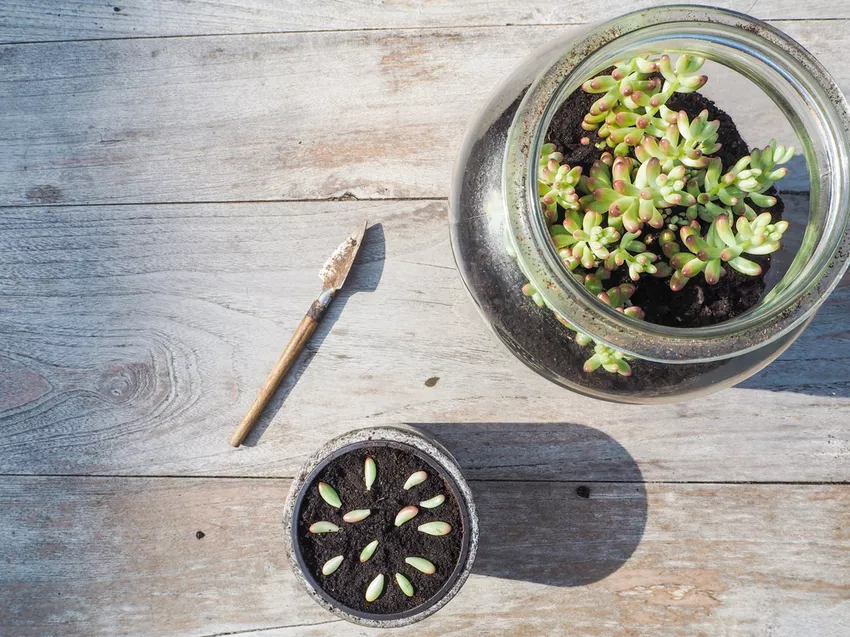- Offspring on a silver platter - that's how it works with children
- Propagating succulents with leaf cuttings - this is how you do it right
- Sowing seeds - instructions for generative propagation
- Protection against fungi and mold is the be-all and end-all
Succulents make life easy for their gardener. This does not only apply to care. The strikingly shaped ornamental plants are also very easy to propagate. This guide explains the best methods step-by-step. This is how it works with children, cuttings and seeds.
 Succulents are very easy to propagate
Succulents are very easy to propagate
Offspring on a silver platter - that's how it works with children
Succulents that grow unbranched give their gardener ready-made offspring in the form of offshoots. These side shoots mostly thrive at the base as a baby variant of their mother plant. While with other plant species you have to wait until a child has its own roots with the separating cut, this premise is not absolutely necessary with succulents. How to properly cut and care for a cutting:
- Detach a child when it has clearly assumed the shape of its mother plant
- Ideally, grasp the offshoot between two fingers and break off
- Alternatively, cut off with a sharp, disinfected knife
- Allow the cut to dry in an airy place for 1 to 2 days
Put the side shoot with the dried cut surface in a pot with slightly moist succulent or cactus soil. Press the substrate firmly to create a good ground contact. After a period of regeneration of about a week, water and fertilize a child like its mother plant.
Propagating succulents with leaf cuttings - this is how you do it right
Succulent species with rich leaves, such as money trees, agaves or lucky feathers, offer the leaf cutting method for propagation. The aim here is that a leaf roots along the wound incision and allows one or more offspring to sprout. The best time for this form of propagation is early spring in order to use the summer vegetation phase for growth. Here's how to do it professionally:
- Fill a bowl or pot with a mix of succulent soil and coconut fiber
- Spray the substrate with soft water
- Break off or cut off the desired number of sheets
- Using a razor blade, cut a thin strip from the edge of the leaf to reveal the sap-rich tissue
- Lay the cut cuttings flat on the moist substrate and press down lightly
- Place in a partially shaded, warm window seat
One or more mini succulents grow along the exposed tissue. If the substrate dries, spray it with room-warm water. When the rooted plants have reached a growth height of 2 to 3 cm, they can be cut off from the leaf cuttings. Planted in small pots with succulent soil, growth and rooting will continue quickly. Since the fresh roots are very sensitive, please drill a small planting hole for each plant.
Sowing seeds - instructions for generative propagation
Vegetative propagation with children or leaf cuttings produces only a limited number of young succulents. If you are aiming for a whole flock of young plants, the focus is on generative propagation with seeds. The sowing process is not only more labor-intensive, but also more tedious and requires a good deal of finesse. How to master the challenge:
- Fill a seed tray with lean potting soil over a 1 cm high expanded clay drainage
- Moisten the substrate well with lime-free water
- Then sieve the seed soil thinly with lime-free quartz sand
- Scatter the succulent seeds on top and press lightly with a board
- Cover the seed pot with a pane of glass or cover with cling film
- Set up in a partially shaded location at 21 to 25 degrees Celsius
The germination time depends on the respective succulent species. As a rule, germination begins within 2 to 3 weeks. Under the protection of the cover, a warm, humid microclimate is created that does not require additional watering. Seedlings should not be exposed to direct sunlight during this period. As soon as the first seedlings sprout, the hood has done its job, because now your pupils need fresh air. On average, after 12 months, succulent seedlings are mature enough to be pricked out.
Protection against fungi and mold is the be-all and end-all
Fungal spores are your succulent younglings worst enemy. This applies equally to the vegetative and generative methods. Therefore, clean bowls and pots with hot water before use. Tools should always be disinfected with spirit.
Please pay special attention to the substrate. Before kindling, cuttings or seeds come into contact with it, it should be sterilized. Fill the earth into a fireproof bowl, spray it with a little water and put a lid on loosely. All pathogens are reliably killed off in the oven on the middle rack at 150 degrees top and bottom heat within 20 to 30 minutes.
tips
Branching succulents, such as various Euphorbia species or cactus species, can be propagated very well via their branches. Cut a healthy branch off the trunk and let the cut dry for a while. Then place one third of the offshoot upright in a pot with succulent soil, support it with a wooden stick if necessary and care for it like its mother plant.